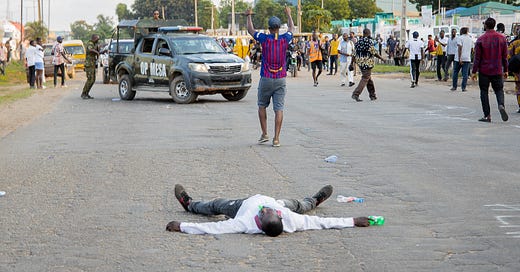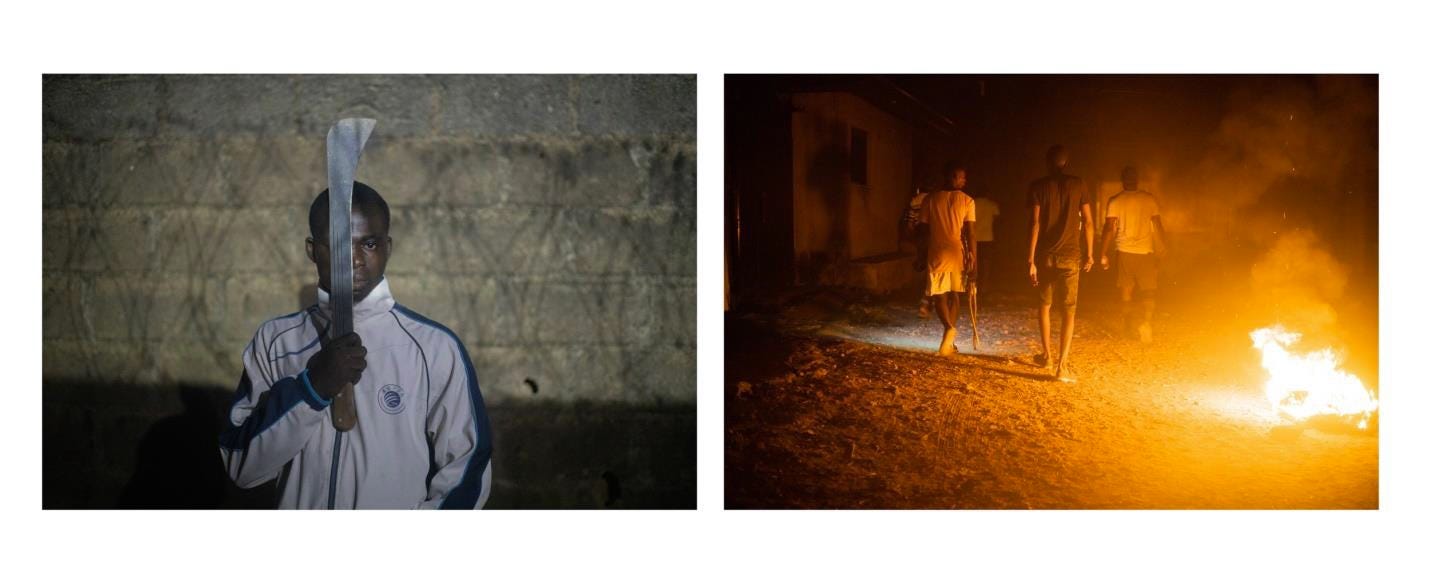The photograph can be described as having four characters: a man sprawled on the ground, another raising his arms, an army van with an armed soldier poised to enter then another looking in the direction of the photographer, and finally, a sprinkling of people, milling past, or standing to watch, drawn to or away from the spectacle. What spectacle? The man sprawled on the ground is either helpless or playacting; whether it is the former or latter, his cohort is the man who’s gone on ahead. And the crowd, watching it all, seem to know, as individuals or as a potential mob, whose side they’ll take in the event of a mishap—see the man with a phone for instance, equidistant from the army truck and the spread-eagled man. The man walking towards the van has held up his thumbs: to acknowledge the soldiers, to moderate their jitters.
Omoregie Osakpolor: “Every photographer has to use their work for social impact.”
I took this photograph during the ENDSARS protest in Alausa, in October 2020.
During the protest in Alausa, the Lagos-Ibadan Expressway was routinely barricaded from 12pm till 6pm daily. On this day, the vehicle of the Nigerian Army drove on the wrong side of the road in order to by-pass the barricade and protesters on the other side of the road. I thought there was going to be a clash when I saw protesters running towards the vehicle, so I instantly focused my lens on the man who laid on the road daring the Nigerian army to come run over him. Instinctively, the soldiers drove away.
The photograph is special to me because of the attitude of the protester—the bravery, of not just the man laying on the road, but of every Nigerian youth who protested. The moment reminded me of “The Tank Man.” The ENDSARS protest was an awakening—an awakening of a generation that had been infamously termed “a phone pressing generation of lazy youths.” The awakening did not just birth a new sense of national identity amongst Nigerians, it sowed the seed of hope in the hearts of millions of young Nigerians who came together for the first time in a long time to collectively demand for a working nation for all without ethnicity, religion or political affiliations creating a divide. This is what makes this image special to me—it’s like he was saying to the government “I dare you.”
My society influences my work. Each project I work on requires a different artistic approach, though there is a certain element that runs through all:socio-politics. When a project idea comes to my head, I do a bit of research on the idea before thinking of the best way to tell the story visually. Like Ousmane Sembène said about a political film not being a political banner, but a piece of art, so it is with a documentary photography project that addresses a political issue. It is not a political banner, it is art. I ask myself, what’s the best way to approach it? Would I be using artificial or natural light? What lens would fit this and why? Should I shoot outdoors or indoors? Etc. These are some of the thoughts that go on in my mind before I decide on the artistic concept to tell that particular story.
Photography is a powerful tool because it has the power to sway and shape public opinion and mindsets. It’s been used over the years by different governments, institutions and organizations for different purposes,for good and bad.
This, for me, is why I believe every photographer—especially the Nigerian documentary photographer—has a responsibility to use their work for social impact. There is so much happening around us and to us Nigerians, that as photographers, we cannot afford to just make images for the sake of making them. I’ve always pictured photographers (artists generally) as watchmen of society because of how easily their works influence people. Imagine what happens to a city where the watchmen are always drinking and sleeping (trivializing the duty given them) when they are supposed to be on guard? You know what happens to that kind of city, right? Destruction will creep in on them! The colonialists and imperialists invested so much in anthropological photography and it helped them create a keyhole view of Africa to their people back home, and that perception has shaped how their people see Africans till date. African photographers have and are still undoing that perception with counter-narratives about the continent and its people. It is great that African photographers are now intentional about the stories that they tell and how the continent is presented. Here, photography is a political instrument being used to represent ourselves and how we want to be seen and defined.
While it is great that we are documenting and pushing the positives about us to the world, we mustn’t shy away from presenting our problems to ourselves. This is one of the functions of photography—a tool for social engagement. Our problems as Africans (and Nigerians in particular) are so intricate; issues of bad governance, poverty, insecurity, equal gender rights, social welfare, etc., and we must talk about them. We cannot find solutions to what we fail to shine a light on. As such the photographer mustn’t be afraid to address the diverse challenges in the country for the fear of being tagged a pessimist. This is what influences the kind of work I create. The intention, aside aesthetics, is to highlight societal issues that need to be addressed—to spark up a conversation.
Two other photographs by Omorogie Osakpolor
For each week’s feature, I send 3 photographs to the photographer, and ask them to respond to one. Here are the 2 other photographs I selected from Omorogie’s portfolio and sent to him. What do you think about any of them? You can respond as a comment below.
What to Watch
This week, I’m watching masterclasses on Blind magazine, a noteworthy photography platform. For instance, all 17 minutes of Charles Traub’s masterclass is worth listening to. “The camera does not see as the human eye sees,” he says. “It’s got its own properties, it has no memory, it has no history, it doesn’t tell tell the truth, but it has its own set of facts.”
Thank you for reading and sharing this feature on Omorogie Osakpolor. You can see more of his work on Instagram.
Every week I feature one photograph and the photographer who took it. You’ll read a short caption from me, and a statement from the photographer. My goal is to set up conversations with the work of early to mid-career African photographers. You can support the newsletter by asking someone—or 10 people!—to subscribe.








The second and third photos are somehow linked for me, the young men leaving behind a still lit fire, the older man on a bed, left alone. I once thought of starting a photography and poetry project around the question - What happens to what is left behind? After the photographers, the news and the people have moved on, how do the people that cannot move on live? In Nigeria, recently there was an explosion caused by a faulty gas pipe close to a secondary school. What happens to the people who lost homes and livelihood after everyone else has moved on? What happens to artists who are unable to stay beneath the camera flash as they grow older? Maybe I will go back to it.